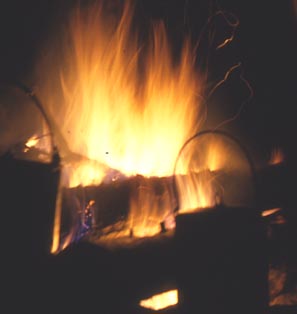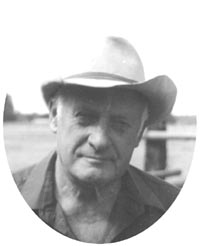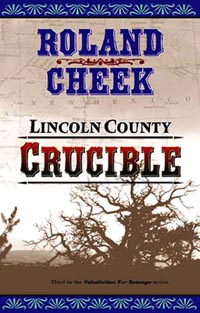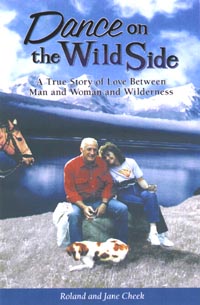a weblog sharing info on outdoor skills and campfire musing by a guy who spends a bunch of time in pursuit of both
CULTURE
WHERE -
TALES ARE TOLD OF
Welcome to Roland Cheek's Weblog
Roland is a gifted writer with a knack for clarifying reality. Looking forward to more of his wisdom
- Carl Hanner e-mail
General William Tecumseh Sherman no doubt had it right when he said: "I'm sick and tired of war. Its glory is all moonshine. It is only those who have never fired a shot nor heard the shrieks and groans of the wounded who cry aloud for blood, more vengeance, more desolation. War is hell."
To access Roland's weblog and column archives
Tip o' the Day
Cooking baked potatoes in the campfire is easier if you pre-bake them about three-quarters done at home. Wrap in foil, then finish in campfire coals. The upside is that it won't take long.
Take along some big plastic bags for camp garbage. Even if you use burlap oat sacks, the plastic bags will keep the throw-aways from oozing.
A good hot weather tip is to cover your ice chest with a sleeping bag or two during the day. No, no -- it's not to keep the chest warm, but to keep it cool -- provided you cover it early in the day, while ambient air temperature is still cool. And keep the chest in the shade.
Jane repackaged from jars to plastic as much as possible, or purchased foods already packaged in plastic. There are plastic canisters for peanut butter and squeeze bottles of good-tasting jams and jellies.
She packaged individual salads in Seal-A-Meal bags: three-bean, pasta, marinated corn.
And she pre-cooked roasts, hams, and sometimes chicken, packaged the meat in zip-lock bags and froze it to ward off spoilage. All the above saves an unbelievable amount of weight for a float trip, or horseback packtrip.
Years ago we did it differently -- lots of jars and cans and fresh meat, whole potatoes, and store-bought pastries and cookies. Then she tried repackaging from jars and found she could eliminate 35 pounds of glass from one of our eight-person, ten-day hunting trips. By precooking much of the meats, she cut one-quarter of that weight and by packaging in zip-lock bags and freezing, there was no apparent loss in flavor.
While we were still guiding professionally, Jane baked all our wilderness trip cookies at home -- 320 dozen (3,840) homemade cookies for one season alone! All were baked and packaged for each individual trip, then stored in our freezer for timely use.
Desserts were tasty stir-and-serve pie fillings poured into already prepared cut-and-serve crusts. Or it was a stir-and-bake cake cooked in a Dutch oven.
In those days Jane's efficiency was readily apparent when she put together a hot, tasty, full-course meal ready for a troop of hungry guests, guides and their outfitter only an hour after pulling into some secluded and undeveloped campsite.
Echoes of Vengeance -- A military outpost situated in an isolated region of the Department of the Upper Missouri. An embittered Commandant who believes unkind fate kept him from fame and glory during the recent War of Seccession. A band of starving Blackfeet too riddled with smallpox to withdraw to their reservation. A young mixed-blood army interpreter whose aging parents are with the Blackfeet tries to prevent a massacre-in-the-making; he's beaten and dragged to the guardhouse for the attempt.
Thus the stage is set and principal characters in place for the opening pages of Echoes of Vengeance * Mule Milk News / Official Newsletter of the Montana Outfitters and Guides Association
OUTDOORS INEXPERTISE
Much as I hate to admit, there've been times when I've had my head up my rear. Even yet. Even now that I'm into my seventh decade, am the repository of all the World's Knowledge, and should know better.
During one particular year, I 'collect there was little snow on the lower elevations. Far different from the previous winter when snowfalls followed one after another from October through March. Not so during the particular winter in which I'm sharing my ignorance. All through November and December, Jane and I hiked lower elevation mountain country without a single thought of danger lurking above. New Year's Day found us in the Flathead's remote North Fork, near Polebridge, following wolf tracks in an inch or so of fresh snow, wearing hiking boots--sans skis or snowshoes.
Imagine, New Year's Day! Such a nice, easy winter!
All the above is why it was a total surprise to awaken the next morning to the news that eleven people had died in snowslides on the very same weekend that Jane and I had tramped after wolves in a skiff of snow. A potpourri of avalanches in western Montana, north Idaho and southeastern British Columbia clamed a climber, eight backcountry skiers, and two snowmobilers. The news report said one Idaho snowmobiler and one British Columbia skier was yet missing.
Meanwhile Jane and I tramped blithely on, never once understanding (because only a skiff of snow lay at the levels we hiked) that peril could be trembling on mountain slopes above. There's monstrous irony there--not that Jane and I were exposed to danger, but that we didn't even suspect we might be exposed to danger.
According to local avalanche experts, we learned that year's mountain snowpack was expecially unstable; the layers of various snowfalls had not bonded well due to changing sequences of frigid cold and balmy chinooks. Though treacherous conditions had been reported, recreationists continued to venture onto the slopes and ridges of surrounding peaks. Reports trickled in of snowmobilers in the Whitefish Range and climbers in Glacier Park narrowly escaping avalanches occurring in mid-December.
I remain convinced there is no such thing as risk-free adventure. And life without any element of risk would, to me, be a sterile one, hardly worth living. So given a choice, I'll accept a little risk in order to experience life. But I'd like to know I'm doing so in order to weigh its pros and cons; to carefully evaluate it in order to make prudent choices.
Jane and I have, in a sense, hung out our shingle as outdoors experts. How could we possibly explain to our believing readers that we perished in a cascading snowslide we didn't even suspect could happen? Imagine the ignominy of a newspaper headline that reads: UNSUSPECTING OUTDOORS EXPERTS BURIED IN AVALANCHE WHILE ROASTING WEENIES IN REMOTE MOUNTAIN GLADE.
After all, being an expert at anything has its responsibilities. One of those responsibilities is not becoming a casualty of the very thing you're supposed to know a bunch about.
Naturally Jane holds me directly to blame for damaging her reputation. "Everything I know about the outdoors," she says, "I learned from you. Now I find I should've been takng my tutoring elsewhere."
We began studying avalanche cause and effect. Fortunately, one of our greatest friends, the late John Montagne, Professor Emeritus of Geology from Montana State University was also one of America's leading avalanche experts. A few of the things he told us were:
* Pay attention to where snowslides occurred before, downhill bands of stunted trees, or where scattered large trees have had their limbs stripped from the uphill side.
* Even slopes of 30 degrees or less can be dangerous, especially below ridgetop cornices, or at the bottom of steeper slopes.
* Listen. Most avalanches signal their start with some noise as a slab of snow breaks loose to cascade down, picking up debris.
With luck, Jane and I won't be there to hear or see it.
We have, however, skied upon the results of recent avalanches: huge blocks of snow, tumbled trees, rocks and dirt piled in a "fan" near the bottom of the little valley we traveled. "Well," I said to Jane, "at least we're safe here."
That's why we were surprised to find, when we took friends of ours up to view the spot, that a second avalanche had cascaded over the first sometime during the week we were gone.
Outdoors inexpertise, indeed!
Roland Cheek wrote a syndicated outdoors column (Wild Trails and Tall Tales) for 21 years. The column was carried in 17 daily and weekly newspapers in two states. In addition, he scripted and broadcast a daily radio show (Trails to Outdoor Adventure) that aired on 75 stations from the Atlantic seaboard to the Pacific Ocean. He's also written upwards of 200 magazine articles and 12 fiction and nonfiction books. For more on Roland, visit:
www.rolandcheek.com
Recent Weblogs
Tuesday, February 3, 2009
There's a bunch of specific info about Roland's books, columns, archives and radio programs. By clicking on the button to the left, one can see Roland's synopsis of each book, read reviews, and even access the first chapter of each of his titles. With Roland's books, there's no reason to buy a "pig in a poke."
for detailed info about each of Roland's books
Read Reviews
Read their first chapters
For interested educators, this weblog is especially applicable for use in history, economic, and government classes, as well as for journalism students.
Roland, of course, visits schools. For more information on his program alternatives, go to:
NEXT WEEK:
UNCONDITIONAL LOVE
www.campfireculture.com
Roundup Magazine says of The Silver Yoke, the final book in the acclaimed Valediction For Revenge series: This novel has lots of action, a terrific villain you love to hate, the smell of dust and dynamite, and a man sworn to bleed his enemies, not of blood but of money, the only they love.
This is another page turner from Cheek with characters that possess all three dimensions and are tough to kill. Any readers who likes action, adventure, and a plot with more twists than a sidewinder will love Gunnar's Mine * Roundup Magazine
Lincoln County, New Mexico, where poor farmers and ranchers are at the mercy of crooked merchants, the military, and a corrupt territorial government run by something called the "Sante Fe Ring," But who are the "good" guys? Billy the Kid? John Chisum?
Book three in the Valediction For Revenge series, the completion of Jethro Spring's adventures in New Mexico
Crisis On the Stinkingwater is Cheek's darkest book. It is also the most realistic. The portrayal of the depth of hatred engendered by the bitter conflict between rancher and homesteader chills the reader * Roundup Magazine
Two books -- one about the people, the second about their place of adventures
For detailed information about Roland's books
source links for additional info
to visit Roland's newspaper columns and weblog archives
to send this weblog to a friend
to tell Roland what you think of his Campfire Culture weblog
-










